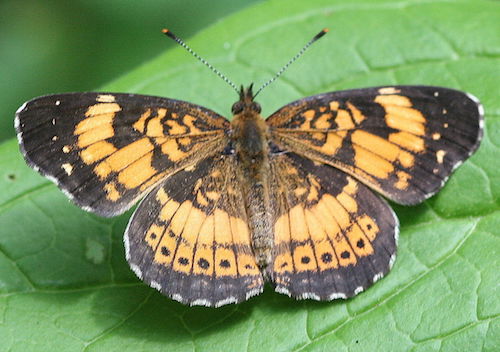Sunflower Insects
Silvery checkerspot, or sunflower butterfly, Closyne nycteis (Lepidoptera: Nymphalidae)

Adult silvery checkerspot

Larval cluster of silvery checkerspot
Although similar in appearance and biology to the painted lady, the silvery checkerspot has more yellow and less red coloration on the wings. The lower surface of the hind wing bears a large, white crescent on its margin. The larvae are dark and covered with branching bristles with a distinctive yellow line running down each side of the body. There are initially gregarious, but disperse once their initial food plant is consumed.
Females lay their eggs in relatively large clusters, often as many as 100. It is also sometimes called the sunflower butterfly because it has a strong preference for the Asteraceae. In Kansas, there are typically two generations per year. Although the first generation lays its eggs too early to be of concern to commercial sunflowers, the flight of the second generation can coincide with the period of crop development. Even large plants can be completely skeletonized by larval feeding, but more damage can occur when egg clusters are laid on young plants in the V4-V6 stage, in which case the entire plant is quickly consumed and larvae migrate to neighbouring plants, sometimes creating a bare hole in the field.
This butterfly is rarely abundant enough to warrant treatment in commercial fields, but localized feeding damage can be dramatic and alarming, raising the need for grower recognition of this species. Aside from the potential for complete destruction of very young plants, significant defoliation will reduce yield, especially if it occurs during early reproductive stages when leaves can no longer be replaced. The action threshold for defoliation of established plants is 25 %, but treatment can only be justified if larvae are still less than 3.0 cm (1 1/4 inch) in length, as larger larvae will soon cease feeding.
Please refer to the most recent Sunflower Insect Management Guide for control options.
Page last updated 10/02/2013 by J.P. Michaud.